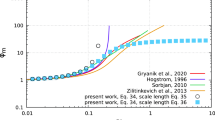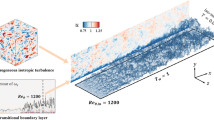Abstract
We assess the performance of turbulence closures of varying degrees of sophistication in the prediction of the mean flow and the thermal fields in a neutrally-stratified Ekman layer. The Reynolds stresses that appear in the Reynolds-averaged momentum equations are determined using both eddy-viscosity and complete differential Reynolds-stress-transport closures. The results unexpectedly show that the assumption of an isotropic eddy viscosity inherent in eddy-viscosity closures does not preclude the attainment of accurate predictions in this flow. Regarding the Reynolds-stress transport closure, two alternative strategies are examined: one in which a high turbulence–Reynolds–number model is used in conjunction with a wall function to bridge over the viscous sublayer and the other in which a low turbulence–Reynolds-number model is used to carry out the computations through this layer directly to the surface. It is found that the wall-function approach, based on the assumption of the applicability of the universal logarithmic law-of-the-wall, yields predictions that are on par with the computationally more demanding alternative. Regarding the thermal field, the unknown turbulent heat fluxes are modelled (i) using the conventional Fourier’s law with a constant turbulent Prandtl number of 0.85, (ii) by using an alternative algebraic closure that includes dependence on the gradients of mean velocities and on rotation, and (iii) by using a differential scalar-flux transport model. The outcome of these computations does not support the use of Fourier’s law in this flow.















Similar content being viewed by others
References
Andrén A (1991) A TKE-dissipation model for the atmospheric boundary layer. Boundary-Layer Meteorol 56:207–221
Apsley DD, Castro IP (1997) A limited-length-scale k-\(\epsilon \) model for the neutral and stably stratified atmospheric boundary layer. Boundary-Layer Meteorol 83(1):75–98
Brost RA, Wyngaard JC, Lenschow DH (1982) Marine stratocumulus layers. Part II: turbulence budgets. J Atmos Sci 39:818–836
Caldwell DR, van Atta CW, Helland KN (1972) A laboratory study of the turbulent Ekman layer. Geophys Fluid Dyn 3(1):125–160
Coleman GN (1999) Similarity statistics from a direct numerical simulation of the neutrally stratified Planetary Boundary Layer. J Atmos Sci 56(6):891–900
Coleman GN, Ferziger JH, Spalart PR (1990) A numerical study of the turbulent Ekman layer. J Fluid Mech 213:313–348
Csanady GT (1967) On the “resistance law” of a turbulent Ekman layer. J Atmos Sci 24:467–471
Cushman-Roisin B, Beckers JM (2010) Introduction to geophysical fluid dynamics. Pearson Education, London
Daly BJ, Harlow FH (1970) Transport equations in turbulence. Phys Fluids 13(11):2634–2649
Detering HW, Etling D (1985) Application of the E-\(\epsilon \) turbulence model to the atmospheric boundary layer. Boundary-Layer Meteorol 33(2):113–133
Deusebio E, Brethouwer G, Schlatter P, Lindborg E (2014) A numerical study of the unstratified and stratified Ekman layer. J Fluid Mech 755:672–704
Duponcheel M, Bricteux L, Manconi M, Winckelmans G, Bartosiewicz Y (2014) Assessment of RANS and improved near-wall modeling for forced convection at low Prandtl numbers based on LES up to Re=2000. Inl J Heat Mass Transf 75:470–482
Gibson MM, Launder BE (1978) Ground effects on pressure fluctuations in the atmospheric boundary layer. J Fluid Mech 86(3):491–511
Irwin HPAH (1973) Measurements in a self-preserving plane wall jet in a positive pressure gradient. J Fluid Mech 61:33–63
Johnstone JP, Flack KA (1996) Review—advances in three-dimensional turbulent boundary layers with emphasis on the wall-layer regions. J Fluids Eng 118:219–232
Kader BA (1981) Temperature and concentration profiles in fully turbulent boundary layers. Int J Heat Mass Transf 24(9):1541–1544
Kannepalli C, Piomelli U (2000) Large-eddy simulation of a three-dimensional shear-driven turbulent boundary layer. J Fluid Mech 423:175–203
Kays W, Crawford M, Weigand B (2005) Convective heat and mass transfer, 4th edn. McGraw Hill, New York
Kays WM (1994) Turbulent Prandtl number—where are we? J Heat Transf 116(2):284–295
Kebede W, Launder BE, Younis BA (1985) Large-amplitude periodic pipe flow: a second-moment closure study. In: 5th symposium on turbulent shear flow, pp 1623–1629
Launder BE (1976) Heat and mass transfer, Chap. 6. In: Bradshaw P (ed) Turbulence, vol 12. Topics in applied physics. Springer, Berlin, pp 231–287
Launder BE, Spalding DB (1972) Lectures in Mathematical models of turbulence. Academic Press, London
Li D (2019) Turbulent Prandtl number in the atmospheric boundary layer—where are we now? Atmos Res 216:86–105
Malin MR, Younis BA (1990) Calculation of turbulent buoyant plumes with a Reynolds stress and heat flux transport closure. Int J Heat Mass Transf 33(10):2247–2264
Marlatt S, Waggy S, Biringen S (2012) Direct numerical simulation of the turbulent Ekman layer: evaluation of closure models. J Atmos Sci 69:1106–1117
Mauritsen T, Svensson G, Zilitinkevich SS, Esau I, Enger L, Grisogono B (2007) A total turbulent energy closure model for neutrally and stably stratified atmospheric boundary layers. J Atmos Sci 64:4113–4126
Miyashita K, Iwamoto K, Kawamura H (2006) Direct numerical simulation of the neutrally stratified turbulent Ekman boundary layer. J Earth Simulator 6:3–15
Momen M, Bou-Zeid E (2017) Mean and turbulence dynamics in unsteady Ekman boundary layers. J Fluid Mech 816:209–242
Müller H, Younis BA, Weigand B (2015) Development of a compact explicit algebraic model for the turbulent heat fluxes and its application in heated rotating flows. Int J Heat Mass Transf 86:880–889
Schlichting H, Gersten K (2006) Grenzschicht-Theorie, 10th edn. Springer, Berlin
Sogachev A, Kelly M, Leclerc MY (2012) Consistent two-equation closure modelling for atmospheric research: buoyancy and vegetation implementations. Boundary-Layer Meteorol 145:307–327
Sous D, Sommeria J (2012) A Tsai’s model based S-PIV method for velocity measurements in a turbulent Ekman layer. Flow Meas Instrum 26:102–110
Spalart PR (1989) Theoretical and numerical study of a three-dimensional turbulent boundary layer. J Fluid Mech 205:319–340
Spalart PR, Coleman GN, Johnstone R (2008) Direct numerical simulation of the Ekman layer: a step in Reynolds number, and cautious support for a log law with a shifted origin. Phys Fluids 20(10):101507
Wilcox DC (1993) Turbulence modeling for CFD. DCW Industries Inc, La Cãnada
Wirth A (2010) On the Ekman spiral with an anisotropic eddy viscosity. Boundary-Layer Meteorol 137(2):327–331
Younis BA (1987) EXPRESS: a computer programme fortwo-dimensionalturbulent boundary layer flows. Department of CivilEngineering, City University, London
Younis BA, Speziale CG, Berger SA (1998) Accounting for the effects of system rotation on the pressure-strain correlation. AIAA J 36(9):1746–1748
Younis BA, Speziale CG, Clark TT (2005) A rational model for the turbulent scalar fluxes. Proc R Soc A Math Phys Eng Sci 461(2054):575–594
Younis BA, Weigand B, Laqua A (2012) Prediction of turbulent heat transfer in rotating and nonrotating channels with wall suction and blowing. J Heat Transf 134(7):071702
Acknowledgements
Lukas Braun gratefully acknowledges the financial support provided by the Studienstiftung des deutschen Volkes that facilitated this research at UC Davis.
Author information
Authors and Affiliations
Corresponding author
Additional information
Publisher's Note
Springer Nature remains neutral with regard to jurisdictional claims in published maps and institutional affiliations.
Appendix: Comparisons with the DNS of Deusebio et al. (2014)
Appendix: Comparisons with the DNS of Deusebio et al. (2014)
A reviewer drew our attention to the DNS results of Deusebio et al. (2014) for the mean temperature and vertical heat flux in a neutrally-stratified Ekman layer. These results are presented in Fig. 16 where they are compared with the present predictions. In the viscous sub-layer (\(z^+<8\)), the correspondence between the DNS results for mean temperature and the predictions of the differential and the non-linear flux models is quite close. However, differences appear further away from the surface. There, the pronounced change in the slope of the temperature profile exhibited by the DNS is not reproduced in the models’ predictions. Concerning the vertical turbulent heat flux, significant differences between the present results and the DNS are apparent. We are at a loss to explain the observed differences in the profiles shape, especially in the outer region of the boundary layer where the DNS results show an extensive region of constant heat flux. We are however encouraged to see that the two models yield almost identical results even though they differ in so many ways (e.g. algebraic vs. differential), and share no assumptions in their formulation.
DNS and present predictions of mean temperature (top) and vertical heat flux (\(Re = 1600\)). \(\bigcirc \) DNS of Deusebio et al. (2014);
 differential transport model;
differential transport model;
 non-linear model
non-linear model
Rights and permissions
About this article
Cite this article
Braun, L., Younis, B.A. & Weigand, B. A Turbulence Closure Study of the Flow and Thermal Fields in the Ekman Layer. Boundary-Layer Meteorol 175, 25–55 (2020). https://doi.org/10.1007/s10546-019-00495-8
Received:
Accepted:
Published:
Issue Date:
DOI: https://doi.org/10.1007/s10546-019-00495-8





